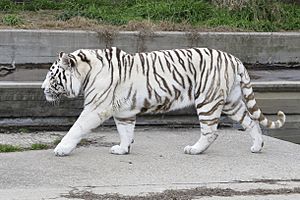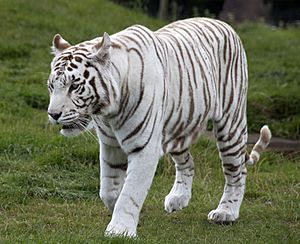White tiger facts for kids
The white tiger or bleached tiger is a special type of Bengal tiger. It has a unique white or near-white fur color, but still has the typical black stripes of a tiger. These rare tigers have been seen in the wild from time to time in parts of India, especially in the former State of Rewa.

Contents
What Makes White Tigers Special?

White Bengal tigers are easy to spot because of their fur color. Their white fur happens because they lack a pigment called pheomelanin. This is the same pigment that gives orange Bengal tigers their color.
White Bengal tigers often grow faster and become heavier than orange tigers. They are also usually a bit bigger when they are born and when they are fully grown. White tigers are fully grown by the time they are 2 to 3 years old. Male white tigers can weigh up to 230 kilograms (507 pounds) and grow up to 3 meters (10 feet) long.
Just like human fingerprints, every tiger's stripes are unique. No two tigers have the exact same stripe pattern. These stripes are actually part of their skin's color. So, even if a tiger's fur were shaved, you would still see its stripe pattern on its skin!
It's very rare for a white Bengal tiger to be born in the wild. Both parent tigers must carry a special gene for white coloring. This only happens naturally about once in every 10,000 tiger births. Today, there are hundreds of white tigers living in zoos and wildlife centers around the world. About one hundred of them are in India. Their unique white fur makes them popular attractions at zoos and in shows. They are rare in the wild possibly because their white color doesn't help them hide as well when hunting prey or avoiding other animals.
How White Tigers Get Their Color
A white tiger's light color comes from a lack of red and yellow pigments called pheomelanin. These pigments usually create the orange color in tigers. Scientists used to think this was due to a change in a gene called TYR, which is linked to albinism. However, recent studies using whole genome sequencing found that white tigers have a normal TYR gene.
Instead, the white color in tigers is caused by a natural change in a different gene called SLC45A2. This change affects how a certain protein works, which then stops the red and yellow pigments from showing up in the fur. This is a recessive trait. This means a tiger must inherit two copies of this changed gene (one from each parent) to be white.
Because it's a recessive trait, all cubs born from two white tigers will also be white. However, white tigers can also be born from two orange Bengal tigers if both parents carry one copy of the special white gene. To produce more white tigers in captivity, people sometimes breed tigers that are closely related. This is called inbreeding. While it helps produce white tigers, it can also lead to other health problems.
The color of a white tiger's stripes can also vary due to other genes. Some white tigers have very pale stripes and are called snow-white or "pure white." White tigers, like Siamese cats and Himalayan rabbits, have special enzymes in their fur that react to temperature. This can make their fur grow darker in colder weather. For example, a white tiger named Mohini was whiter than her relatives because she spent less time outdoors in the winter.
Tigers with Very Few Stripes
Another genetic condition can make a tiger almost completely white, with very few stripes. These stripes are so faint that you can only see them in certain lighting. One such tiger was shown in England around 1820.
The modern line of snow-white tigers with few stripes came from breeding closely related tigers at the Cincinnati Zoo. This close breeding seems to have caused a recessive gene to become active, leading to the stripeless look. About one-fourth of the cubs from these specific parents were born without stripes. These stripeless white tigers have since appeared in zoos in different countries.
In 2004, a blue-eyed, stripeless white tiger cub was born in a wildlife refuge in Spain. Its parents were normal orange Bengal tigers. The cub was named "Artico," meaning "Arctic."
Health Issues in White Tigers
Many white tigers born in captivity, especially those from mixed Bengal and Siberian tiger families, can have crossed eyes. This condition is called strabismus. It happens because the visual pathways in their brains are not formed correctly. When white tigers are stressed or confused, they often cross their eyes. This eye problem is directly linked to the white gene itself, not just to inbreeding.
Orange tiger cubs born in the same litter as white tigers usually do not have crossed eyes. However, Siamese cats and albino animals of many species also show similar visual pathway problems. Because of this issue, white tigers may have trouble with spatial orientation, meaning they might bump into things until they learn to adjust. They also suffer from photophobia, which means they are sensitive to bright light, much like albinos.
Other health problems that can be seen in white tigers include:
- Shortened tendons in their front legs.
- Club foot, where the foot is twisted.
- Kidney problems.
- Arched or crooked backbones.
- Twisted necks.
- Reduced ability to have cubs and more miscarriages.
- A condition called "star-gazing," where the tiger holds its head and neck almost straight up.
One male white tiger named 'Cheytan' died in 1992 from problems with anesthesia during a dental procedure. It seems white tigers can react unusually to anesthesia. This might be because they cannot produce normal tyrosinase, a trait they share with albinos.
There is a common belief that 80% of white tiger cubs die young. However, this is a myth. The rate of infant deaths for white tigers born in captivity is not higher than for normal orange tigers born in captivity. Zoos have reported that white tigers can live long lives, similar to other tigers. While some deformities have been reported, many of these might be due to inbreeding or how the tigers are cared for.
Breeding White Tigers

Since the white tiger gene is very rare in the wild, the group of white tigers available for breeding in captivity was small. The last white tiger seen in the wild was reportedly shot in 1958. Today, there are many white tigers in zoos and wildlife centers.
To increase the number of white tigers, breeders sometimes use a method called outcrossing. This means breeding white tigers with unrelated orange tigers. The cubs from these pairings will be orange, but they will carry the white gene. These orange cubs can then be bred with other tigers carrying the white gene to produce more white tigers. This method helps bring new genes into the white tiger family, making them healthier and reducing the problems caused by inbreeding.

Some zoos have worked to breed white tigers. However, to protect the health and genetic diversity of tigers, the Association of Zoos and Aquariums (AZA) decided in 2011 to stop its member zoos from intentionally breeding white tigers. They explained that focusing on a specific appearance, like white fur, can lead to a loss of genetic variety and cause health problems. They believe that animals with unusual appearances do not represent their species well for public education.
|
See also
 In Spanish: Tigre blanco para niños
In Spanish: Tigre blanco para niños
- Black tiger
- Cat coat genetics
- Conservation genetics
- Golden tiger
- Inbreeding
- Inbreeding depression
- Mukundpur
- White panther
- White Tiger (mythology)





